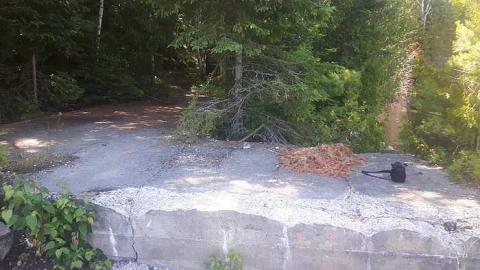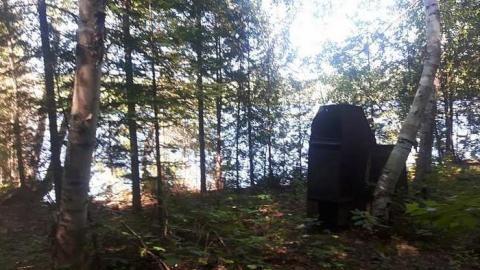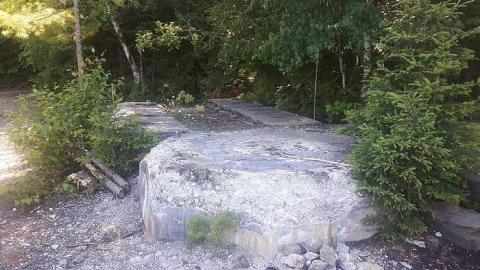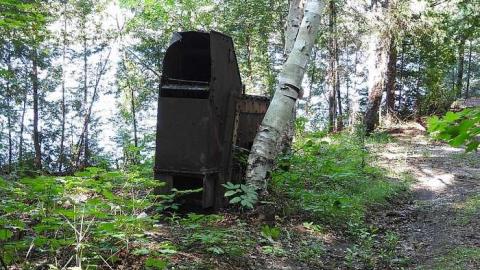About this location
[b][color=#f80404]The Bi - Ore Mine was another historical copper mine that was first discovered by the Bourke and Mills Ltd. in 1926. Company officials would additionally option this mining zone to many different exploration companies before selling this claim in 1928. Before the claimed mine site became sold it was previously option to another company that was known as the Markus Daly Estate in 1928.
Within 1929, White Lakes Mines, Limited had take over this operation with 2,000,000 shares at 1 par value. During this time period the president of the company was known as W. A. Lamport, and the secretary was J. C. Allan, and W. J. McCallum, and D. G. Miller as directors. Much of the property held by this company had consisted of 10 claims within the Township of Iron Bridge, Ontario, Canada. Work at the time was mainly focus on constructing all the much needed buildings, and the transportation of a plant. The newly installed plant was rather place into operation, and drilling was then commenced on May, 2, 1929.
Underground work at the time had mainly consisted of driving two adits under the surface showing, and drifted on the vein. In total development footage the adits along with the drifts had amounted to 2,050 feet of total lateral development. Much of the mining plant at the time had consisted of a 600 cubic foot Sullivan Compressor, directly connected to a 120 H.P Fairbanks Morse Diesel type engine, a Sullivan Drill Sharpener, and a hand forge. A total of 31 men at the time had also been employed within the mining operation under the direction of G. G. Castens as manager.
Mining operations in 1930, were continued throughout the year with the exception of October, 10, and November, 12, 1930. At one point in time, the property had lie under township 1 A within the Mississagi Foreset Reserve, within the Algoma District. Most of all the development at the time was focus on the West, and East Adits of the White Lake Mine Site. Lateral development at the time had also continued to expand the East Adit by 486 feet of drifting, and the West Adit had amounted to 904 feet of drifting, and crosscutting, and 84 feet of raising. Diamond drilling was also being accomplish when 1,652 feet of drilling was completed. No additions were also made towards the Diesel Mining Plant in 1930.
Work by the White Lakes Mines was carried on form January, 1 to May, 5 1931. Most of the ground during this time period was also focus on underground explorations work from the East Adit. In total lateral development the East Adit was considered to have been extend by 430 feet of drifting, and crosscutting. A minor amount of test pitting, and trenching was also completed at the time before the mining operation had ceased by May, 5, 1931. Most of the work was probably caused due to much of the vein not deemed profitable in regards to finding new vein material at further depths.
The Algoma Copper Mines, Limited was incorporated on March, 1942, with a capitalization of 3,000,000 shares of no par value. It was during 1943, when the Company had leased the Bio-Ore Property from the White Lake Mines. By 1943, this whole entire mining operation was undergoing a new ownership change when all mining, and development rights became acquired by the Algoma Copper Mines Limited. The lease during that time period had consisted of 10 claims with approximately 400 acres to work with. Most of the work by the newly incorporated company was aimed at conducting further exploratory work by surface trenching, and test pitting the area further. All exploratory work on this property was first started on August, 1, and had continued till December, 31, 1943. A total of nine diamond drill holes were driven, in which had amount to 2,200 feet of core in total length completed from these holes. Other exploratory work was also carried out when 1,200 feet of surface trenching was done to a depth of 6 feet. A bulk sample at the time was also taken that amounted to 400 tonnes of copper ore that was taken from this trench.
By 1944, the Algoma Copper Mines, Limited had rather change their name to Bi-Ore Mines, Limited, with a capitalization of 3,000,000 shares of $1 par value. Upon incorporation the company was well known for taking over the property from the White Lake Mines, Limited, Mining operations on the newly formed Bi-Ore Copper Property were once again commenced from September, 1 to December, 31, 1947, Most of the work at the time was mainly being done towards further exploratory work along the surface, and the building of more structures. Some of the much needed structures included a flotation mill building, camp building, blacksmith shop, and boiler pump house. There was also a 25,000 gallon water tank added, and mining equipment had consisted of a 500 C.f.m Canadian Ingersoll Rand Air Compressor.
During 1948, the Bi-Ore Mines, Limited, had continued to further develop the West Adit when thirty feet of raises were driven. All of this was done in order to further explore the West Adit in obtaining more copper worth mining. The Flotation Milling facility of 100 tonnes was also completed during that year, and a total of 450 tonnes of copper concentrate was shipped to the copper refinery owned by the International Nickel Company at Copper Cliff. Ore that was obtained from this project was mainly done by open-cutting into the raise from the West Adit. Milling and Crushing within the Bi-Ore Mine was being achieved by two 100 H.P Diesel Powered Motors. The Crushing facility had also consisted of a 20 by 20 foot New Holland Crusher that had crushed the ore into finer pieces before it was shipped to the Copper Cliff, and Noranda Smelters.
Mining operations during 1949, were confined to 870 feet of raises that were driven on the West Adit. Construction at the time was also aimed at developing a new dry, and warehouse. Production from the West Adit had amounted to 2,408 tonnes of copper concentrates were obtained by open cut raise methods, and shipped to Noranda for further treatment. The ore milled in 1948 and 1949 was obtained from the stope and open-cuts that became extracted above the West Adit Zone. In 1948, the company had processed at total of 3,471 tons of ore, and would average 3.74% Copper, and a 28.9% copper concentrate was made, and shipped to the smelters. Within the first six months of 1949, a total of 9,547 tons of ore was milled, and showed an average head assay of 4.90% copper. The Concentrate shipped in this time period was known for averaging 30.85% Copper, and 7.9% Moisture. During this whole entire period of copper production in 1948 and, 1949, 2,726 tons of concentrate became shipped. All these shipments had contained 1,647,079 pounds of copper valued at $335,998. . A total of 44 men were also employed under the direction of L. H. Foran, who was the company's manager.
During 1950, the Bi-Ore Mines had mainly confined mining operations towards further exploring the area. Most of this at the time was also done when diamond drilling of 11 surface holes had commenced, and totalled 2,809 feet in length. No other work at the time was done by this company, and a total of 3 men were employed by the company.
Another major disaster would occur within the year of 1950, when the milling operation had caught on fire that resulted in huge amount of damages. Generally this had caused the final shutdown of the Bi-Ore Mine when the company didn't think it was worth the time and effort to develop a new mill. Production from this mining operation was also becoming exhausted as the West Adit Zone was depleting in resources. Almost all the ore was reported to have been extracted from the west adit stope, and open-cuts that became establish along the West Adit zone.
One last exploration was escalated in the year of 1983 when the Canamex Resource Inc. had staked this claim. Much of these exploration procedures had taken place within The Cobre Lake Property, and had consisted of 10 surface diamond drill holes, totalling 4,000 feet and sampling.[/color][/b]




